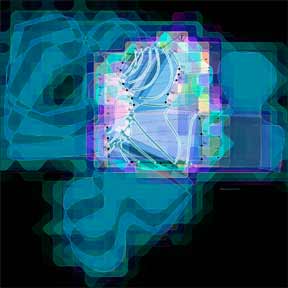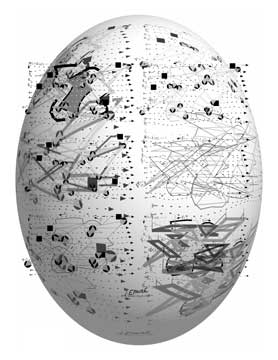The History of Computer Graphics and Digital Art Project.
by Anna Ursyn.
Describe your field. Why are you interested in Computer Art/ Computer Graphics and what (event, need, idea, hope, obstacle) caused your involvement? Summarize your line of development (the essence of your input to the field) in relation to concurrent technology.
S.E. Trained and making a living in electronics (1956-1964), I switched to painting my stronger call (1961-1967). Accepted, in 1967, as member of the Romanian Alliance of the Fine Artists I become a full time professional painter. I found myself in the position of blending in one person scientific and artistic abilities. Soon I entered a period of serious study in information theory, cybernetics, structuralism, constructivism etc. I envisioned my art as an expression of dynamic natural processes which convey information and involve actions, reactions, changes of state, behaviors. But this is already putting cybernetics, as the creative engine at the core of my art .
Does the computer allow you to think visually about some topic or process in new ways? How has this influenced your work? Describe your ultimate accomplishment.
S.E. By the end of 1966, two directions had emerged and remained the chief focus of my work to this day:
![]()
![]() 1. The S-Bands (Sherban's bands) which initiates a cybernetic relationship between the viewer and itself, therefore producing an interactive situation. The S-Band is essentially an interactive aesthetic machine that can combine twelve partly independent visual messages simultaneously, thus generating a large number of alternative possibilities. Playing with the Birkhoff formula, (aesthetic value= order / complexity) and the value of the information / redundancy in a message, one can control each alternative in order to maximize its visual impact.
1. The S-Bands (Sherban's bands) which initiates a cybernetic relationship between the viewer and itself, therefore producing an interactive situation. The S-Band is essentially an interactive aesthetic machine that can combine twelve partly independent visual messages simultaneously, thus generating a large number of alternative possibilities. Playing with the Birkhoff formula, (aesthetic value= order / complexity) and the value of the information / redundancy in a message, one can control each alternative in order to maximize its visual impact.
and
![]()
![]()
 2. The creation of algorithms, protocols and behavioral activities embedded in geometry. A film or a final image graphically follows and describes the unfolding of the process. I called Meta-Phorms (Meta-Metaphor-Form) the components of such a geometry. The Meta-Phorm is conceived as a mathematical statement and is therefore media independent; that is, it can be, at the minimum, expressed even with a pencil and a piece of paper. The result may be a drawing or painting with its own aesthetic value. On the other hand, it may never reach its full potential in the absence of specialized tools capable of providing intense calculation, sophisticated graphic representation, and purity in expression. For obvious reasons, the computer is the ideal too here, but in the sixties and seventies, it was in its infancy and only a dream for the end-user. During the period when the technology and computational equipment were absent, I replaced the computer by my brain and the plotter by my hand. Today I take full advantage of the available technologies which make sense for my art.
2. The creation of algorithms, protocols and behavioral activities embedded in geometry. A film or a final image graphically follows and describes the unfolding of the process. I called Meta-Phorms (Meta-Metaphor-Form) the components of such a geometry. The Meta-Phorm is conceived as a mathematical statement and is therefore media independent; that is, it can be, at the minimum, expressed even with a pencil and a piece of paper. The result may be a drawing or painting with its own aesthetic value. On the other hand, it may never reach its full potential in the absence of specialized tools capable of providing intense calculation, sophisticated graphic representation, and purity in expression. For obvious reasons, the computer is the ideal too here, but in the sixties and seventies, it was in its infancy and only a dream for the end-user. During the period when the technology and computational equipment were absent, I replaced the computer by my brain and the plotter by my hand. Today I take full advantage of the available technologies which make sense for my art.
Has the field of computer art and graphics progressed in the ways that you expected? What has surprised you? What do you like about its progress and what do you wish had happened differently? What do you think the future holds for visual computing in science/art? Please make some predictions or wish lists for the near- and long-term future.
S.E. The computer art have progressed in ways more diverse than I first expected. This is driven primarily by the evolution, in the last decades, of the processor / memory / storage devices working group. Without the progresses in the physics of semiconductors (for the preocessors) and magnetism, allowing for huge storage spaces, the potential of the processors would have been bottlenecked. I am sure, in future, unexpected practical applications of the physics will allow the advent of very complex and fast software and hardware.
Describe your dream environment for enhancing your project ideas. What are your preferred tools for creating and how do they work? What tools (hardware/software) you have used initially had the strongest impact on your work?
As a very early Macintosh user (1987) I had the opportunity to experiment (sometimes as a beta tester) most of its dedicated hardware/software, be it for print, illustration, photography, 3D, animation, presentation, drafting, packaging, etc., but I did it always with one eye on what would specifically help my art/painting or its promotion. The list will be to long to mention them all, needless to say that many have disappeared, have been redesigned or re incorporated in more complex applications. I am always open for the use of any tools or fine art materials compliant with my idea of art.
Describe how you think specific advancements in technology, such as wireframe, hidden line removal, scanner, laser, HTML, Java applets, or any other advancement determined the way the approaches to creating art/graphics evolved?
S.E. In my hopes, I expected the technology to grow much faster from 1974 on, but it happened it was an unrealistic expectation. While print was the major hope during the 80s and 90s it had to wait until 2000 for additional peripherals to reach maturity such as good and affordable high rez scanners and digital cameras, inks (from dyes to pigment), printers (from 4 to 8 colors), paper (from regular to digitally compliant) huge storage spaces (from megabytes to gigabytes and soon to terabytes) allowing manipulation of image, sound and presentation. In the mean time starting the 90s the advent of camcorders, DVDs, HTML, Flash, Director, sound and presentation technologies opened an unexpected and prolific approach to art. Therefore digital/electronic art grows today in many directions; print, high rez photography, animation, interactive, web.
How would you characterize the milestones (every ten years) in the development of computer technology? Which ones were most influential in art/graphics?
S.E. See above.
Which persons would you indicate as the pioneers in the particular areas/stages in which decade?
S.E. From 1956--1976: Charles Churi, Nam June Paik, Georg Nees, Frieder Nake, Herbert Franke, Vera Molnar, Manfred Mohr, Roman Verostko, Sue Golifer and others.
Later on, Barbara Nessim, Laurence Gartel, Jeremy Gardiner and others.
My works, both in Europe and in the States, (S-Bands and Meta-Phorms), uninterrupted since their first presentation in 1970, encompass the last 30 years.

